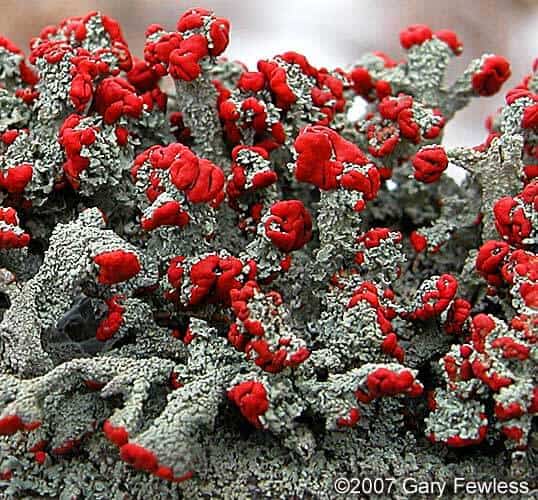A red dye derived from lichens that has been used for centuries to color fabrics and food appears to reduce the abundance of small toxic protein aggregates in Alzheimer’s disease. The dye, a compound called orcein, and a related substance, called O4, bind preferentially to small amyloid aggregates that are considered to be toxic and cause neuronal dysfunction and memory impairment in Alzheimer’s disease. O4 binding to small aggregates promotes their conversion into large, mature plaques which researchers assume to be largely non-toxic for neuronal cells. Further research with animal models is needed to determine whether this new approach by Dr. Jan Bieschke (Max Delbrück Center for Molecular Medicine, MDC, Berlin-Buch), Dr. Martin Herbst (Charité — Universitätsmedizin Berlin) and Professor Erich Wanker (MDC) in Berlin, Germany, will be useful for therapy development (Nature Chemical Biology, doi: http://dx.doi.org/10.1038/NCHEMBIO.719)*.
Protein misfolding is considered to be the cause of Alzheimer’s, Parkinson’s and also Huntington’s disease. In a multistep process, proteins misfold and accumulate into large extra- or intracellular plaques. Researchers assume that small misfolded protein aggregates that are precursors of mature plaques are toxic for nerve cells and are the reason why they are eventually destroyed.
Dye from the Canary Islands
The dye orcein is isolated from lichens that grow on the Canary Islands, among other places. Lichens have been used for centuries to color fabrics and food. Eight years ago Professor Wanker screened hundreds of natural compounds to find potential candidate drug molecules for the treatment of neurodegenerative diseases. Among those substances he found orcein, a compound made up of about 14 small molecules. As these molecules might have different biological effects, the researchers in Berlin began to search for pure chemicals with similar properties. They identified the substance O4, a blue dye, which is structurally very similar to one of the 14 molecules. Moreover, they showed that O4 stimulates the formation of large, non-toxic protein plaques from small toxic protein assemblies.
New Mechanism
A few years ago Professor Wanker and his colleagues discovered that EGCG (Epigallocatechin-3-gallate), a natural chemical compound found in green tea, renders toxic protein assemblies non-toxic. With orcein and O4 the researchers have now found another mechanism to eliminate small toxic protein aggregates. However, instead of remodeling protein plaques, the dyes reduce the abundance of small, toxic precursor protein assemblies by accelerating the formation of large plaques, as the researchers could now show in their laboratory.
“This is a new mechanism,” Professor Wanker explained. “Up to now it has been considered to be very difficult to stop the formation of small toxic protein assemblies. If our hypothesis is correct that the small aggregates, which are precursors of plaques, indeed cause neuronal death, with O4 we would have a new mechanism to attack the disease.”
The synthetic dye methylene blue is currently being tested in clinical trials. This dye also seems to stimulate the formation of large plaques in a way similar to O4. Other therapeutic approaches tested in clinical trials which aim at eliminating small precursor aggregates have so far not led to a significant improvement of disease symptoms.
However, it still remains to be seen whether the blue dye O4 can also be effective against small amounts of misfolded proteins in the brains of Alzheimer’s patients and whether the accelerated formation of larger plaques can indeed reduce the signs and symptoms of Alzheimer’s disease in humans. Further studies will be necessary to address the question whether the accelerated formation of large plaques can be a therapeutic approach. “We hope that our findings will stimulate research activities in this direction, especially in drug discovery,” Professor Wanker said.
*Small-molecule conversion of toxic oligomers to nontoxic b-sheet — rich amyloid fibrils
Jan Bieschke1,12, Martin Herbst1,2,12, Thomas Wiglenda1, Ralf PFriedrich1, Annett Boeddrich1, Franziska Schiele1, Daniela Kleckers1, Juan Miguel Lopez del Amo3, Björn Grüning4, Qinwen Wang5,11, Michael RSchmidt1, Rudi Lurz6, Roger Anwyl5, Sigrid Schnoegl1, Marcus Fändrich7, Ronald F Frank8, Bernd Reif3,9, Stefan Günther4, Dominic M Walsh10 & Erich EWanker1
1Neuroproteomics, Max Delbrück Center for Molecular Medicine, Berlin, Germany. 2Department of Neurology, Charité-Universitätsmedizin Berlin, Germany. 3Leibniz Institute for Molecular Pharmacology, Berlin, Germany. 4Institute for Pharmaceutical Sciences, University of Freiburg, Germany. 5Department of Physiology, School of Medicine, Trinity College, Dublin, Republic of Ireland, 6Max Planck Institute for Molecular Genetics, Berlin, Germany. 7Max Planck Research Unit for Enzymology of Protein Folding, Halle (Saale), Germany. 8Department of Chemistry, Helmholtz Center for Infection Research, Braunschweig, Germany. 9Technical University Munich, Munich, Germany. 10Laboratory for Neurodegenerative Research, The Conway Institute for Biomolecular and Biomedical Research, University College Dublin, Republic of Ireland. 11Present address: Department of Physiology and Pharmacology, Medical School, Ningbo University, Ningbo, China. 12These authors contributed equally to this work.
Barbara Bachtler
Press Department
Max Delbrück Center for Molecular Medicine (MDC) Berlin-Buch
in the Helmholtz Association
Robert-Rössle-Straße 10; 13125 Berlin; Germany
Phone: +49 (0) 30 94 06 – 38 96
Fax: +49 (0) 30 94 06 – 38 33
e-mail: [email protected]
Further information:
http://www.mdc-berlin.de/en/research/research_teams/index.php?type=person&char=w

If our reporting has informed or inspired you, please consider making a donation. Every contribution, no matter the size, empowers us to continue delivering accurate, engaging, and trustworthy science and medical news. Independent journalism requires time, effort, and resources—your support ensures we can keep uncovering the stories that matter most to you.
Join us in making knowledge accessible and impactful. Thank you for standing with us!

